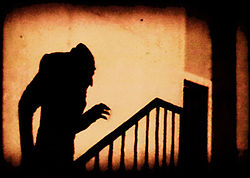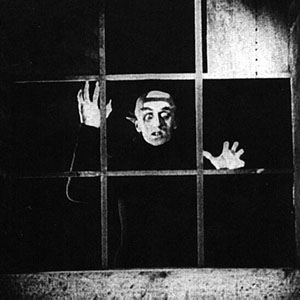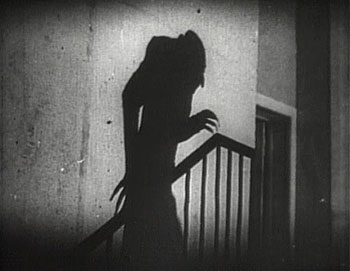 Delving back into the past this week I thought we should take a look at something a little less obscure. Something well known, iconic, and above all feature length. Nosferatu: A Symphony of Horror is not only an all time classic work of cinema, it is in fact one of the great staples of geekdom.
Delving back into the past this week I thought we should take a look at something a little less obscure. Something well known, iconic, and above all feature length. Nosferatu: A Symphony of Horror is not only an all time classic work of cinema, it is in fact one of the great staples of geekdom.
We’re all familiar with the iconic scenes of this movie. The shadow creeping up the stairs, the demonic vampire rising stiff as a board out of a coffin. Above all else, we know this as perhaps the first real horror film.
 What I find interesting about this picture are the similarities that can be found between it and the 1940 landmark Dracula. I still find the latter quite scary to watch, and that is all down to the presentation of Bela Lugosi in the title role. A grim facial expression, pinpoint lighting of the eyes, and a lack of music all combine to elicit a genuine chill whenever the vampire is shown in close-up. This is also the case in Nosferatu, particularly in scenes where the vampire is stalking his victims, creeping closer and closer to the viewer with each cut.
What I find interesting about this picture are the similarities that can be found between it and the 1940 landmark Dracula. I still find the latter quite scary to watch, and that is all down to the presentation of Bela Lugosi in the title role. A grim facial expression, pinpoint lighting of the eyes, and a lack of music all combine to elicit a genuine chill whenever the vampire is shown in close-up. This is also the case in Nosferatu, particularly in scenes where the vampire is stalking his victims, creeping closer and closer to the viewer with each cut.
Also, quite frankly the hideous grotesqueness of Max Schreck’s Count Orlok actually help to make a case for this version of the preeminent vampire being the scariest. He looks like a rat, and thus shocks on a more visceral level than his suave counterpart.
To be considered a part of the genuine horror canon a film has to have certain traits. It needs to be iconic, influential, perhaps genre-defining or re-inventive. This movie has all of those characteristics, and most importantly of all I would argue that in the truest sense of terror: all alone late at night and watching the film with the lights off, knowing that you can scream if you want to and nobody will hear, this film can still scare you nearly one hundred years after it was made.
So much has been said about this film already that I cannot truly do it justice. All I can ask is that tonight, after dark, you watch it for yourself and see if it’s worth all that praise.
http://youtu.be/oohUl8WYOZA



